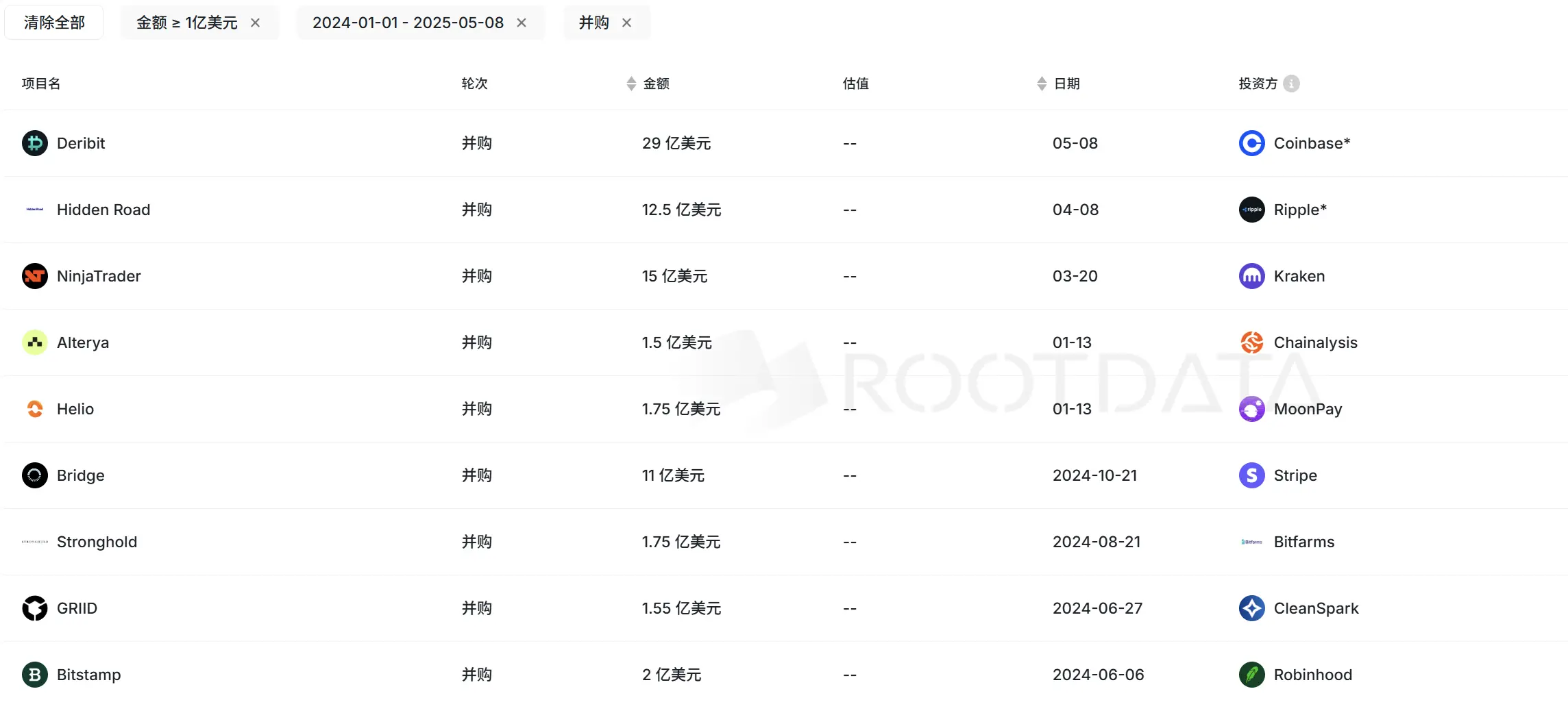Author: flowie, Fairy, ChainCatcher
Editor: TB, ChainCatcher
Recently, Coinbase announced its acquisition of the cryptocurrency options exchange Deribit for $2.9 billion, which includes $700 million in cash and 11 million shares of Coinbase Class A common stock. This transaction breaks the previous record set by Kraken's $1.5 billion acquisition, making it the largest acquisition in crypto history.
As the largest cryptocurrency options exchange by market share, Deribit saw Bitcoin options trading volume and Ethereum options trading volume reach 80% and 90%, respectively, during the bull market of 2024. Why choose to exit at this peak? How will the landscape of the crypto derivatives market be reshaped after Coinbase's expensive acquisition of Deribit?
The Development Legend of Options King Deribit
Deribit was registered in the Netherlands in 2016, co-founded by brothers John Jansen and Marius Jansen.
The establishment of a cryptocurrency options exchange stemmed from the practical needs of the younger brother, Marius, who was among the earliest Bitcoin investors and needed to hedge risks. However, at that time, the derivatives market in crypto was still blank, so he sought the help of his brother John, who had a professional background in options trading. John has been involved in options trading since 1998, previously working as a trader at the Amsterdam Options Exchange, and is currently the CEO of Deribit.
Initially, Deribit focused on Bitcoin options and futures trading, filling a gap in the cryptocurrency derivatives market at that time. In 2017, Deribit launched Bitcoin perpetual contracts, becoming one of the first exchanges to offer such products.
After 2018, the futures trading market began to grow, with Huobi and Binance also entering the futures market. Despite facing competition, Deribit, which entered the market early in 2019, became the world's largest Bitcoin options exchange due to its professional options experience and low fees, maintaining a dominant position in this market. By early 2020, Deribit's market share in Bitcoin options had reached as high as 86%.
Subsequently, Deribit raised over $140 million through three rounds of financing to accelerate its expansion. QCPCapital, Three Arrows Capital, 10T Holdings, and Akuna Capital were among the investors behind it.

Although Deribit's user base mainly consists of demanding professional investors and institutional users, it has maintained a good reputation in its pursuit of growth, with very few negative incidents.
In the bull market of 2024, Deribit once again experienced significant growth, with its annual trading volume surpassing $1.1 trillion, a year-on-year increase of 95%. The options trading volume grew by 99%, while spot trading volume achieved an astonishing growth of 810%. The platform's daily trading volume once exceeded $1.9 billion, and the total open interest reached a historical high of $48 billion on November 28, 2024.
Deribit has also continued to solidify its dominant position in the crypto options market, with its Bitcoin options trading volume accounting for over 80% of the total market trading volume, and Ethereum options trading volume reaching as high as 90%.
Deribit's business spans across 160 countries and regions, and after obtaining a license from the Dubai Virtual Assets Regulatory Authority (VARA) in 2024, it found new growth opportunities.
Why Did Deribit Choose to "Exit the Rapids" at Its Peak?
Throughout Deribit's growth, it has faced two key issues: compliance challenges and growth bottlenecks.
In 2020, to avoid the EU's strict KYC requirements, Deribit moved its operational base to Panama. In 2023, to cope with regulatory pressure, Deribit further relocated to Dubai. This February, due to sanctions imposed by the EU, Deribit had to announce its exit from the Russian market.
Deribit CEO Luuk Strijers has repeatedly stated that as global regulatory frameworks continue to strengthen, many crypto trading platforms will exit the market due to high operational costs or direct shutdowns by regulatory agencies, and Deribit itself faces similar challenges.
In addition to compliance issues, breaking through the ceiling may be an even greater challenge for Deribit.
Deribit has extremely limited growth space in the crypto options market and faces the risk of being outcompeted, as other centralized exchanges (CEX) are continuously expanding their derivatives trading functions. Competitors like BitMEX, OKX, and Bybit are strengthening their derivatives offerings, while Kraken has also acquired NinjaTrader for $1.5 billion. These competitors attract a large number of users by offering high-leverage trading, user-friendly interfaces, and low trading fees. Additionally, the rise of decentralized exchanges (DEX) poses certain competitive pressure.
Beyond maintaining its position in the crypto options market, horizontally expanding for growth is also not an easy task for Deribit. The entire crypto industry currently lacks new liquidity, and major players like Binance and OKX are facing internal competition and growth challenges across various sectors. Under regulatory pressure and internal competition, this may mean that Deribit would have to incur higher operational costs for uncertain growth.
In this context, choosing to leverage a merger may be a step for Deribit to transition from maintaining its position to breaking through.
Although Deribit possesses leading technology and market share in the crypto options field, its product line remains relatively singular. A merger with Coinbase could create complementary offerings in spot, futures, and options, building a more comprehensive derivatives ecosystem.
For Coinbase, Deribit could bring approximately $30 billion in open interest and over $1 trillion in trading volume, significantly enhancing its competitiveness in derivatives; for Deribit, leveraging Coinbase's global user base and compliance advantages, especially in the U.S. market, would aid its internationalization.
This acquisition also occurs at a critical juncture of policy shift: with Trump returning to the White House and promoting crypto-friendly policies, the market's demand for compliant platforms has significantly increased. In this context, Deribit's choice to exit at this time may be a wise decision to leverage the situation and move towards the next growth curve.

How Will Coinbase Reshape the Crypto Derivatives Landscape?
Since 2014, Coinbase has completed at least 21 acquisition transactions, and the acquisition of Deribit is its largest transaction to date. This not only marks a strategic upgrade for Coinbase but also highlights the accelerating trend of mergers and acquisitions in the crypto derivatives market.
In addition to Deribit, many derivatives platforms are also "selling themselves." On February 28, CoinDesk reported that BitMEX, a well-established crypto derivatives platform founded by Arthur Hayes, is also seeking a sale. Additionally, the crypto derivatives startup Arbelos Markets has been sold to the crypto brokerage FalconX.
The rapidly growing and maturing crypto derivatives market has become a battleground for leading players. In 2024, the global average daily trading volume in the crypto derivatives market has exceeded $100 billion, with monthly trading volumes surpassing $3 trillion.
In 2024, Coinbase has also been actively expanding its derivatives business, adding over 90 new assets on international exchanges to drive growth in its derivatives trading volume. According to a report by CCData, Coinbase's market share in the derivatives market grew by 3.89% in 2024.
However, compared to building from scratch, mergers and acquisitions can be a quick and effective way to grow. By acquiring Deribit, Coinbase can rapidly enhance the scale and competitiveness of its derivatives business, allowing it to compete with global derivatives giants like Binance and Bybit.
This acquisition could have a profound impact on the landscape of the crypto derivatives market. As market concentration increases, other cryptocurrency exchanges may face strategic adjustments, and even a wave of industry consolidation may occur. Meanwhile, smaller exchanges will face greater competitive pressure and may even become marginalized.
Traditional financial institutions have long entered the crypto market through ETFs and derivatives, and the strong alliance between Coinbase and Deribit will undoubtedly attract more institutional investors, further promoting the integration and intersection of traditional finance and the crypto market.
However, whether Coinbase can maintain Deribit's specialized product style and high standards to effectively serve this market remains to be seen.
The Crypto Industry Faces a Wave of Mergers and Acquisitions
According to RootData, there have been 48 mergers and acquisitions in the crypto space from 2025 to date, averaging nearly 10 crypto acquisitions per month.
In total, there were 105 M&A events in 2024, setting a historical high, a 36.3% increase from 77 in 2023.
In terms of acquisition amounts, there have been 9 acquisitions exceeding $100 million in 2024, with acquisition amounts consistently breaking new highs. Just before Deribit was acquired for $5 billion, Kraken acquired the U.S. futures trading platform NinjaTrader for $1.5 billion in March 2025.

Acquisitions over $100 million in 2024 to date
As the cryptocurrency market matures, the trend of industry consolidation is evident, with only a few platforms likely to emerge as winners.
In the competitive market, giants are rapidly expanding their products and services through acquisitions. For the projects being acquired, in a situation where primary and secondary valuations are inverted, mergers and acquisitions can be a perfect exit strategy compared to issuing tokens.
免责声明:本文章仅代表作者个人观点,不代表本平台的立场和观点。本文章仅供信息分享,不构成对任何人的任何投资建议。用户与作者之间的任何争议,与本平台无关。如网页中刊载的文章或图片涉及侵权,请提供相关的权利证明和身份证明发送邮件到support@aicoin.com,本平台相关工作人员将会进行核查。




